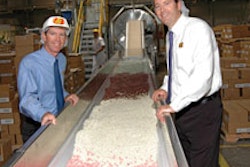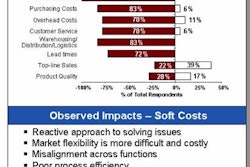During an economic slowdown, most B2B companies are content to do what they've always done — hunker down and start playing defense. They go into survival mode, pulling out all the stops to protect their market share and top-line revenues. And along the way, they hope that cost-cutting measures and efficiency improvements will somehow lessen the blow to their bottom line.
Leading B2B companies have a very different perspective.
They understand how efforts to improve efficiency can quickly reach a point of diminishing returns. They're leery of gutting their core competencies and differentiating capabilities through cost reductions that cut too deep. They realize that aggressive discounting to protect market share can easily wipe out gains in other areas — destroying their profitability and crippling their company's long-term ability to compete.
So how are visionary companies growing their profits and gaining sustainable competitive advantages in the current economic climate? How are these companies positioning themselves to emerge from this economic slowdown in a stronger position than before? What hidden opportunities have these leading companies found that aren't so obvious to their competitors?
Many of these visionaries have now discovered the hidden opportunity in price optimization.
Given the financial variables at play, pricing has a tremendous amount of leverage for B2B companies. Even relatively minor improvements to realized price can have a major impact on profitability. In fact, many B2B companies have found that the bottom-line impact of optimizing their prices and discounts dwarfs those of cost reductions and volume increases combined.
Hidden Opportunity
For most B2B companies, price optimization has largely remained a hidden opportunity because, as powerful as it is, pricing just doesn't get much attention during a market upturn.
In a positive market condition, the rising tide of growth covers a variety of "pricing sins," and B2B companies can get by with fairly rudimentary pricing practices across their thousands of products and customers. As long as revenues and profits are growing at some level, B2B companies give little thought to "what could have been" or, more rightly, "what should have been."
But when growth begins to stall, those inferior pricing practices become a major problem. All of the pricing guesswork, intuition and rules-of-thumb that seem sufficient in a growing market conspire to deprive B2B companies of margin dollars they so critically need in a down market.
So, while their competitors are focused solely on back-end cost cutting and process efficiency, leading B2B companies are also leveraging price optimization technologies on the front end. By deploying this specialized software, they are able to automatically analyze every deal in real time, provide profit-optimal price points to sales people for every product on every order, and ultimately maximize their margin contribution and profitability — all without sacrificing top-line revenue.
And because price improvements drop straight to the bottom line, the impact of price optimization technology is a game changer for B2B companies facing softening demand and material-cost inflation.
For example, after deploying price optimization software, one Fortune 500 industrial manufacturer has watched their operating margins grow by 12.8 percent in the past year. For another Global 1000 manufacturer, price optimization technology produced gains that exceeded their initial expectations and goals by 400 percent — generating $40 million of incremental margin and being recognized as the company's "most impactful growth initiative of the year."
In an economic downturn, financial improvements like these can change a company's fortunes entirely.
The incremental dollars these companies are generating through price optimization can be invested in new manufacturing capabilities and product innovations. Or they can be used to pursue entirely new markets and distribution channels. They might also be leveraged to acquire the other companies that aren't fairing so well in this economic condition.
The point is that while everyone else is just struggling to protect their current levels of profitability, the ability to actually grow operating margins is clearly a significant competitive weapon.
Opportunity Cost
It should also be clear that there's a significant opportunity cost associated with lack-of-action. When it's possible for a B2B company to grow their operating margins 10-15 percent by deploying certain price optimization technologies, every day of indecision or inaction effectively costs them that same amount. For one company, every day of indecision cost them $75,000 in incremental margin dollars that could have been claimed and captured.
As one customer put it: "My only regret is that we didn't deploy the technology sooner. We could've added a million a month to our bottom-line for the year we spent just 'evaluating' the potential."
Recent reports by industry analysts are also now reinforcing the value of price optimization in tough economic conditions. AMR Research states that, "establishing fact-based pricing, improving margin realization, and rectifying unprofitable pricing practices can help companies continue to be profitable during a downturn." (See endnote 1 for source.)
Another analyst firm, Gartner, Inc., notes price optimization as "having a more-direct impact on revenues or margins than any other CRM technology through 2010," (endnote 2) and clarifies in a recently released report why it is so compelling. "The price optimization and management market differs from most other applications because it offers strategic benefits (helping organizations grow revenue and margins) and operational efficiencies (helping companies save time and cut costs)." (Endnote 3.)
So what's the catch?
The catch is that even though the opportunity to change the game through price optimization is available to every B2B company, very few will take any action. The simple truth is that most B2B companies will just continue to do what they've always done. Even knowing that there's a better way, most manufactures will instead choose to hunker down, get defensive and allow sales people to discount their way into a corner just trying to survive.
But some readers will recognize that this is exactly how sustainable competitive advantage is created.
The "hidden opportunity" of price optimization is indeed available to everyone. But in this economy, what will separate the winners from the losers — the emerging leaders from the lagging survivors — is the willingness to take action to turn the opportunity into a reality.
Endnotes
1. Pricing Optimization in a Down Economy: Mandate for Growth or Ill-Timed Choice, Noha Tohamy, April 2008
2. Gartner MarketScope for Price Optimization and Management Technology, 2008 Michael Dunne, March 2008
3. Gartner, Hype Cycle for CRM Sales, 2008, Michael Dunne, June 2008
Leading B2B companies have a very different perspective.
They understand how efforts to improve efficiency can quickly reach a point of diminishing returns. They're leery of gutting their core competencies and differentiating capabilities through cost reductions that cut too deep. They realize that aggressive discounting to protect market share can easily wipe out gains in other areas — destroying their profitability and crippling their company's long-term ability to compete.
So how are visionary companies growing their profits and gaining sustainable competitive advantages in the current economic climate? How are these companies positioning themselves to emerge from this economic slowdown in a stronger position than before? What hidden opportunities have these leading companies found that aren't so obvious to their competitors?
Many of these visionaries have now discovered the hidden opportunity in price optimization.
Given the financial variables at play, pricing has a tremendous amount of leverage for B2B companies. Even relatively minor improvements to realized price can have a major impact on profitability. In fact, many B2B companies have found that the bottom-line impact of optimizing their prices and discounts dwarfs those of cost reductions and volume increases combined.
Hidden Opportunity
For most B2B companies, price optimization has largely remained a hidden opportunity because, as powerful as it is, pricing just doesn't get much attention during a market upturn.
In a positive market condition, the rising tide of growth covers a variety of "pricing sins," and B2B companies can get by with fairly rudimentary pricing practices across their thousands of products and customers. As long as revenues and profits are growing at some level, B2B companies give little thought to "what could have been" or, more rightly, "what should have been."
But when growth begins to stall, those inferior pricing practices become a major problem. All of the pricing guesswork, intuition and rules-of-thumb that seem sufficient in a growing market conspire to deprive B2B companies of margin dollars they so critically need in a down market.
So, while their competitors are focused solely on back-end cost cutting and process efficiency, leading B2B companies are also leveraging price optimization technologies on the front end. By deploying this specialized software, they are able to automatically analyze every deal in real time, provide profit-optimal price points to sales people for every product on every order, and ultimately maximize their margin contribution and profitability — all without sacrificing top-line revenue.
And because price improvements drop straight to the bottom line, the impact of price optimization technology is a game changer for B2B companies facing softening demand and material-cost inflation.
For example, after deploying price optimization software, one Fortune 500 industrial manufacturer has watched their operating margins grow by 12.8 percent in the past year. For another Global 1000 manufacturer, price optimization technology produced gains that exceeded their initial expectations and goals by 400 percent — generating $40 million of incremental margin and being recognized as the company's "most impactful growth initiative of the year."
In an economic downturn, financial improvements like these can change a company's fortunes entirely.
The incremental dollars these companies are generating through price optimization can be invested in new manufacturing capabilities and product innovations. Or they can be used to pursue entirely new markets and distribution channels. They might also be leveraged to acquire the other companies that aren't fairing so well in this economic condition.
The point is that while everyone else is just struggling to protect their current levels of profitability, the ability to actually grow operating margins is clearly a significant competitive weapon.
Opportunity Cost
It should also be clear that there's a significant opportunity cost associated with lack-of-action. When it's possible for a B2B company to grow their operating margins 10-15 percent by deploying certain price optimization technologies, every day of indecision or inaction effectively costs them that same amount. For one company, every day of indecision cost them $75,000 in incremental margin dollars that could have been claimed and captured.
As one customer put it: "My only regret is that we didn't deploy the technology sooner. We could've added a million a month to our bottom-line for the year we spent just 'evaluating' the potential."
Recent reports by industry analysts are also now reinforcing the value of price optimization in tough economic conditions. AMR Research states that, "establishing fact-based pricing, improving margin realization, and rectifying unprofitable pricing practices can help companies continue to be profitable during a downturn." (See endnote 1 for source.)
Another analyst firm, Gartner, Inc., notes price optimization as "having a more-direct impact on revenues or margins than any other CRM technology through 2010," (endnote 2) and clarifies in a recently released report why it is so compelling. "The price optimization and management market differs from most other applications because it offers strategic benefits (helping organizations grow revenue and margins) and operational efficiencies (helping companies save time and cut costs)." (Endnote 3.)
So what's the catch?
The catch is that even though the opportunity to change the game through price optimization is available to every B2B company, very few will take any action. The simple truth is that most B2B companies will just continue to do what they've always done. Even knowing that there's a better way, most manufactures will instead choose to hunker down, get defensive and allow sales people to discount their way into a corner just trying to survive.
But some readers will recognize that this is exactly how sustainable competitive advantage is created.
The "hidden opportunity" of price optimization is indeed available to everyone. But in this economy, what will separate the winners from the losers — the emerging leaders from the lagging survivors — is the willingness to take action to turn the opportunity into a reality.
Endnotes
1. Pricing Optimization in a Down Economy: Mandate for Growth or Ill-Timed Choice, Noha Tohamy, April 2008
2. Gartner MarketScope for Price Optimization and Management Technology, 2008 Michael Dunne, March 2008
3. Gartner, Hype Cycle for CRM Sales, 2008, Michael Dunne, June 2008












